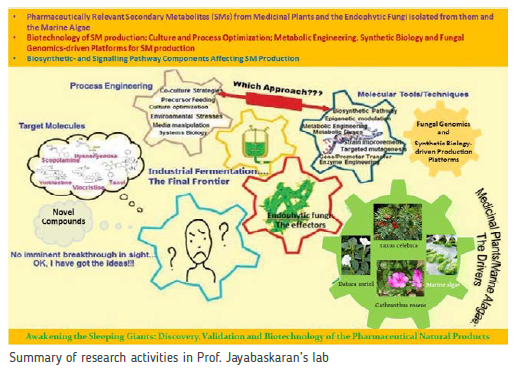C. Jayabaskaran

C. Jayabaskaran
Honorary Professor
Ph.D.: Indian Institute of Science, Bangalore, India
Post-doctoral research:
University of Wisconsin, Madison, USA and Boston
Biomedical Research Institute, Boston, USA
Year of Joining: 1985
Email:cjb@iisc.ac.in
Research in my laboratory encompasses the broad theme of secondary metabolites from medicinal plants and their endophytic fungi. Recently marine algal-derived endophytic fungi are the new addition to this theme. Cost-effective production of the already approved and novel anticancer and other pharmaceutical compounds is possible by industrial fermentation of endophytic fungi and other heterologous microbial hosts producing/engineered to produce these molecules. Several novel lead compounds with potent anticancer and anti-thrombotic properties are at various stages of development.
Highlights
- Bioactive secondary metabolites (SMs) of plant and endophytic fungal origin with a focus on anticancer molecules
- Biosynthetic- and signal-transduction pathway components modulating the secondary metabolite biosynthesis
- Fungal Genomics/Synthetic Biology/Metabolic Engineering-based approaches for SM production
The prominent areas of research in my laboratory focus primarily on pharmaceutically important secondary metabolites produced by medicinal plants and the endophytic fungi from these plants and most recently, the marine algal-derivedendophytic fungi.
Following is a broad overview of the past, current and future research trends in my lab.
Moleculesfor all seasonsThe laboratory has been working on several clinically used anticancer and other pharmaceutical molecules with respect to their isolation from various biological sources such as medicinal plants, plant cell cultures as well the endophyticfungi isolated from these plants. These include a) anticancer vinca alkaloids, vincristine and vinblastine from the medicinal plant Catharanthusroseus and its endophytic fungi; b) the billion-dollar anticancer drug Taxol from endophytic fungi of Taxus celibica and certain endophytic fungi of non-Taxus plants; and c) tropane alkaloids – scopolamine, atropine, hyoscamine, etc.from Datura metel and its endohytic fungi.
Novel Lead Compounds: Several lead anticancer and antithrombotic molecules have been isolated from various endophytic fungi isolated from known medicinal plants such as Catharanthus roseus, Daturametel, Taxuscelebica, Saracaasocaetc. as well as the red, green and brown marine algae collected from various beach locations across south and central India. One such anticancer compound, Cholestanal glucoside obtained from the ednophytic fungus

Biotechnology of the SM production in Plant and Endophytic fungal systems: Our ultimate aim is to explore industrial scale production of these valuable molecules by fermentation technology/cell culture. This entails a complex process of media manipulation, culture elicitation, optimization, stress application, etc. for validation at the laboratory/bench scale for all the culture and process parameters to effect enhanced yield per unit biomass/culture volume. Our laboratory has been conducting these studies for several of the clinically used and some novel validated SMs with varying degree of success. Also, the biosynthetic and signaling pathway components for some of these SMs have already been cloned, validated and are being tested towards metabolic engineering/synthetic biology approaches.
Biosynthetic and Signaling Pathway Components modulating Plant/Endophytic Fungal SMs: The biosynthetic pathway genes for Taxol and vinca alkaloids from Taxus celebica and/or its/other endophytic fungi such as Fusarium solani and Catharanthus roseus/its endophytic fungi, respectively have been cloned and characterized with the next objective of using these as tools for metabolic engineering approaches in the same/heterologous systems in parental/heterologous hosts being actively pursued. Additionally, the signaling pathway components such as protein kinases, transcription factors, chromatin regulators, etc. modulating the biosynthesis of these SMs in plant/endophytic systems have been extensively studied in my group.
Endophytic Fungal Genomics: Recently, we have sequenced the entire genome of the Taxol-producing endophytic fungus, Fusarium solani isolated from Taxus celebica by a combination of Illumina and Nanopore-based technologies. The same is being analyzed with plans to utilize the insights on the biosynthesis of this important anticancer drug in this/other fungitowards engineered production of Taxanes.
Metabolic Engineering/Synthetic Biology of the SM production in Endophytic Fungi/Heterologous Hosts: There have been a plethora of reports on the metabolic engineering of a large number of pharmaceutical SMs as well as biofuels in microbial hosts such as bacteria, S. cerevisiae, etc. We have initiated these studies for some of the SMs being investigated in my laboratory. Taxanes are especially being investigated as a case in point.
Future Directions: The need to find new drugs with minimal side effects and free from the problem of drug resistance is absolutely imperative. The natural products are especially effective against several key cellular components having undergone the molecular fitness tests over evolutionary time scales. The discovery and validation of novel lead anticancer compounds from the terrestrial plants as well as the marine algae-derived endophytic fungi, is being actively explored as a future trend in my laboratory. The biotechnology of the already discovered/proven molecules is the other focus in times to come.
- In vitro and in vivo xenograft model based validation and efficacy studies of novel anticancer secondary metabolites against breast and cervical cancers, DSTSERB (2018 to 2021).
- Metabolic pathway analysis of L-DOPA synthesis in Mucunapruriens L. by characterization of catecholamine pathway with emphasis on modulation of tyrosine hydroxylase gene; Department of Biotechnology; 2015- 2018;
- Search for novel anticancer secondary metabolites from endophytic fungi of selected marine algaeand evaluation of their mechanism of action; DBT; 2017-2020;
- Metabolic engineering for enhanced taxol production in taxol-producing endophytic fungi: a combination of genetic, molecular biology and biotechnological approaches; Department of Science and Technology; 2017-2020;
- Balendra, S., Kamalraj, S., Jayabaskaran, C. (2019) Biochemical insights into the recombinant 10-deacetylbaccatin III-10-β-O-acetyl transfer as enzyme from the Taxol-producing endophytic fungus Lasiodiplodiatheobromae. FEMS Microbiology Letters, fnz072
- Anantha Krishna, TH., Kamalraj, S., Anikisetty, M., Naidu, KA., Surin, WR., Jayabaskaran, C. (2019) Inhibition of thrombin, an unexplored function of retinoic acid. Biochemistry and Biophysics Reports 18:100636.
- Madhuree, K., Taritla, S., Sharma, A. and Jayabaskaran, C. (2018) Antiproliferative and antioxidative bioactive compounds in extracts of marine-derived endophytic fungus Talaromyces purpureogenus. Front. Microbiol. 3, 1777
- Tanushree, N., Vanitha, S. C., Pradumn, K. R., Chandrika, M., Kamalraj, S. and Jayabaskaran, C. (2018). Novel microbial sources of tropane alkaloids: First report of production by endophytic fungi Isolated from Datura metel L. Curr. Microbiol. 75, 206 - 212
- Palem, P. P., Kuriakose, G. C. and Jayabaskaran, C. (2015). An endophytic fungus, Talaromyces radicus, isolated from Catharanthus roseus, produces vincristine and vinblastine, which induce apoptotic cell death. PLoS One. 23, e014447
Ph.D. Students 4
Undergrads 0
Postdocs 11
Trainees 5